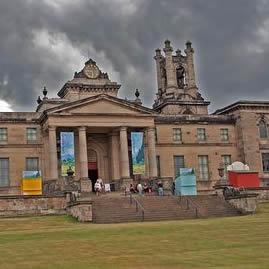Just across the road from the Gallery of Modern Art in Edinburgh’s west end is the Dean Gallery, one of the five constituent buildings which comprise the National Galleries of Scotland. This spring the Dean is showing the works of four Scottish painters: Wilhelmina Barns-Graham, John Bellany, Alan Davie and Anne Redpath, all artists of the post-second world war period.
Barns-Graham became a leading light in the St. Ives school after moving there in 1940 and her abstract canvases show about as much talent as a five year old at a nursery painting table. They have nothing to say. Bellany doesn’t do it for me either. He always just wants to use too much colour and his attention to craft is woeful, particularly in the major piece here The Homecoming, (2008). It’s a work soon to be auctioned and whilst the lower half of the painting is clearly a harbour, the upper half disengages from reality in a melange of primary colour daubing that demonstrates both a lack of touch and a contempt for his audience.
Alan Davie’s influences are jazz, Zen Buddhism, aboriginal art and Native American pottery. Each of these sources can provide a worthy enlightenment for those interested in them. Together, and processed by Davie’s brain, they emerge as a mess – a crude mess at that. Anne Redpath, like Barns-Graham, doesn’t have a lot to say.
This is a deeply disappointing collection of works, in which it is very difficult to find anything worthy of an art gallery, still less a national collection. At a very short distance from from the gallery is an access to the Water of Leith Walkway, which is followed for about a quarter of a mile downstream to the point where the Queensferry Road crosses into the heart of the city. It does so on the back of the 100 foot tall Dean Bridge, by Thomas Telford (1831). This structure is barely noticeable at street level but is the finest work of art in the vicinity. The lines are simple and majestic, the achievement nothing short of outstanding. This bridge opened up Edinburgh to the north west and thereby proved to be a significant element in the city’s growth.
So there you have it. Spirits can be uplifted by seeking out the hidden treasures when the alternative of having them presented in neat packages fails to satisfy. I’m sorry that I can’t be at all positive about this exhibition but I have to call it as I see it, and in the field of human endeavour these paintings represent slight works.





